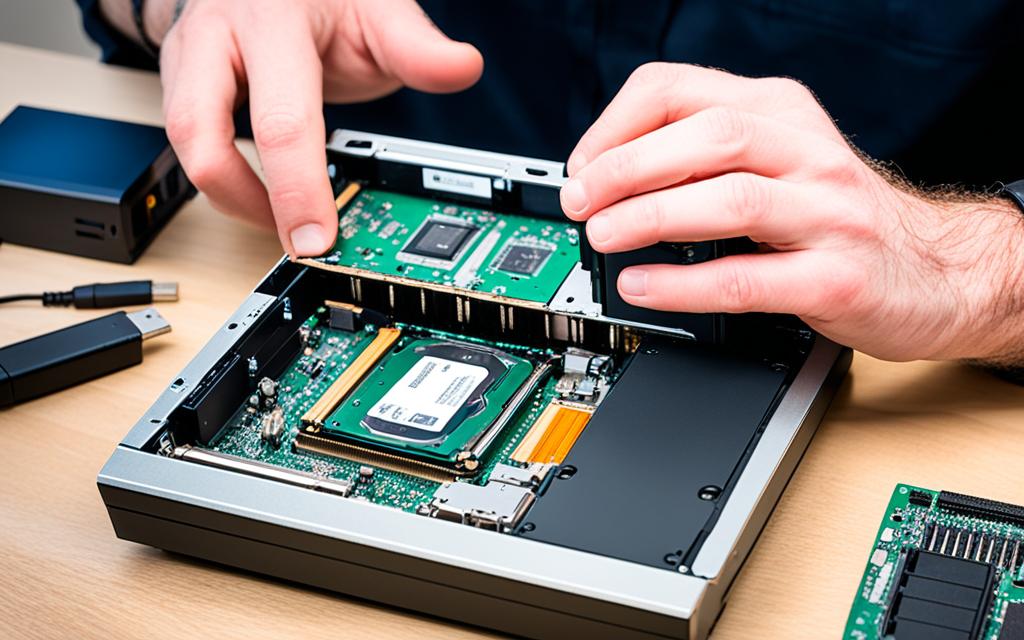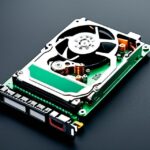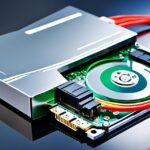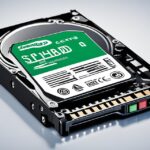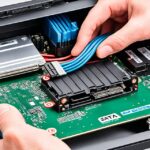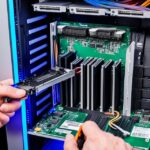Table of Contents
Turning an internal hard drive (HDD) into an external one is both budget-friendly and practical. It lets you reuse old hardware to boost your storage without spending much. But, make sure the drive fits the enclosure to avoid any issues, as about 20% of users encounter problems here. Always check the drive’s specs on the manufacturer’s websites12.
Using standard USB connections makes the change straightforward, especially since most drives now have SATA or mSATA connections. It’s essential, though, to know the difference between SATA and PATA connectors2. Keeping all this in mind, making your internal HDD external is a wise move for more storage space.
Key Takeaways
- Cost efficiency by repurposing internal HDDs into external drives.
- Common compatibility issues can be mitigated through careful verification.
- Standard USB connections ensure ease of use for external HDD setups.
- Understanding the differences between SATA and PATA is essential.
- Size variations for laptop (2.5 inches) and desktop (3.5 inches) drives must be accounted for.
- Utilising docking stations can simplify connections while maintaining compatibility.
Understanding Internal and External Hard Drives
The storage world shows off two main players: internal and external hard drives. The internal one sits inside computers, holding all your files and programs. Meanwhile, the external one is for those who move around, easily connecting through USB.
SATA and PATA are two types of hard drives you’ll find. SATA fits with newer tech, having faster transfers and easier connections. PATA is for older tech but still has its uses. Knowing these helps pick the right storage for your needs.
External drives range from 500MB to 4TB or more. They can back up data for several computers at once3. Think about how much you’ll use it. External drives last longer if kept cool3. Luckily, most computers can connect to them easily thanks to USB ports3.
But it’s not just about size or how to plug them in. SSDs use flash memory, offering quicker access to your files than old-school drives3. Even so, external drives generally last 3 to 5 years, depending on how they’re used and stored4.
Picking between internal and external storages means looking at your needs. Internal ones like BarraCuda keep your files close. But something like Backup Plus, an external drive, means flexibility and mobility5. For those keen on avoiding data loss, external backups are a safe bet5.
In summary, knowing the differences between internal and external hard drives helps in choosing the right storage. It’s key to match your choice with your storage demands.
Benefits of Converting an Internal HDD to an External HDD
Turning an internal HDD into an external one offers many perks. It gives you a cost-effective storage option. By repurposing hard drives that were used before, you can avoid spending a lot on new external drives.
This change makes it easy to keep and back up valuable files. You can store essential documents, multimedia, and backups without paying extra. Being able to switch drives in one casing is a big benefit too.
Also, this shift helps the environment by reducing waste. It lets you use your hardware longer. You still get to pick the best quality and specs for your needs while your data becomes easier to reach.
Moreover, it means you can sort your external drives by use, making your data easier to handle. This blend of usefulness and simplicity shows why it’s a good idea to change internal HDDs into external ones. Learn more about how to do this and the benefits by checking out detailed guides here6.
Choosing the Right External Enclosure
When picking a hard drive enclosure, it’s important to match it with your internal HDD7.Different drives, like the SATA type for desktops or the smaller 2.5-inch for laptops, affect your choice. The enclosure’s material, such as aluminium, also matters due to its durability and ability to keep the drive cool, unlike plastic.
Most enclosures for 2.5-inch and 3.5-inch HDDs use a standard 5 Gbps USB connection, like USB 3.0 or 3.18.For M.2 SSDs, enclosures can allow speeds up to 10 Gbps. Remember, some top-quality enclosures offer Thunderbolt connections for speeds up to 40 Gbps, like the Sabrent EC-UASP, which is great for regular 2.5-inch SSD or HDD and has an on/off switch.
External hard drives come in sizes from 128GB to 10TB, depending on what you need9.Be careful, as some enclosures won’t fit drives over 2 TB. Choosing one that lets your HDD reach its full potential is crucial. Also, bigger 3.5-inch SATA drives usually need their own power source, whereas smaller 2.5-inch versions can often just use USB power.
Ultimately, the key to finding the right enclosure is understanding these considerations to ensure your hardware works well together. For advanced setups, the Orico M2V0-C4 offers strong specs and works with USB 3.x, making it a versatile option.
| Enclosure Type | Speed | Power Source | Recommended Use |
|---|---|---|---|
| Sabrent EC-UASP | 5 Gbps | USB Power | Standard 2.5-inch SSD/HDD |
| Orico M2V0-C4 | 40 Gbps | External Power | Advanced NVMe SSD |
| Premium Thunderbolt Enclosures | 40 Gbps | External, Power |
High-speed Data Processing |
How to Make Internal HDD into External
Turning an internal hard drive into an external one needs the right tools and know-how. This change boosts storage use as well. Knowing what you need, like materials and the best enclosures, is key to a good outcome.
Gather Your Tools and Materials
First, collect these things:
- Internal hard drive
- External hard drive enclosure
- Philips head screwdriver
- Optional: Anti-static mat for protection during handling
Make sure the hard drive can be removed safely. Have the right tools ready to avoid harming the parts. Picking the right hard drive enclosure is essential for an easy switch.
Select the Appropriate Enclosure Size and Connection Type
Picking the right enclosure involves looking at size and how it connects. Laptops mostly use 2.5-inch drives, while desktops use 3.5-inch ones. The external case must fit your drive type — SATA or PATA. Also, think about connection ways, like USB or Thunderbolt, which impact speed and ease. USB-C cases can go up to 5Gb/s. Using SATA-to-USA allows for a cheaper way to reuse drives for extra storage or backup1011.
Steps to Convert Your Internal HDD
Turning an internal hard drive to an external one requires careful steps. We’ll guide you through taking out the internal HDD, readying the drive enclosure, and connecting the HDD inside the enclosure.
Removing the Internal Hard Drive
Begin by removing the internal HDD from your computer. First, turn off the computer and disconnect it. This is to make sure it’s safe. Then, unhook any cables attached to the hard drive. This is usually the SATA connections. Most recent laptop drives are about 2.5 inches, while desktop ones are typically 3.5 inches12. Gently take out the hard drive, taking care not to bend or harm any pins.
Preparing the External Enclosure
Now, turn your attention to preparing the hard drive enclosure. Open it and place the hard drive onto the circuit board firmly. Attach all necessary power and data cables tightly. Select an enclosure made of aluminum or plastic for better cooling and compatibility12. Check that the HDD fits securely, as this is critical for it to work well.
Connecting the Hard Drive to the Enclosure
Complete the conversion by connecting the HDD to the enclosure. Put the connected hard drive back in the enclosure and secure it with screws or clips. Make sure all connections are strong and the enclosure is tightly closed. After assembling, connect the enclosure to a computer using the right cables. This makes your old hard drive easily accessible and extends its life with ease.
Setting Up Your External Hard Drive
After putting your external hard drive together, it’s time to turn it on and connect it to your computer. Making sure it’s set up right is vital. This ensures it works well, letting you get the most out of it.
Powering the Enclosure
It’s important to know if your HDD enclosure needs its own power source or if it can just use USB. Many can run off the USB port, which is really handy. But some need a separate power adapter if they need more power. Getting the power right is key to making sure it runs well and transfers data fast.
Plugging into Your Computer
Start by plugging the USB cable into your computer’s port. Most of the time, your computer will see the new drive right away. It will show you how to get to your files. This easy connection is great for managing your data easily. After that, check the BIOS to make sure your computer is really talking to the new HDD13
Troubleshooting Common Issues
When you change an internal HDD to an external one, some common issues might pop up. Solving these problems can make your experience better and make sure your drive is set up right.
Drive Not Recognised
Not being able to recognise the drive is a common challenge. It might be due to damaged connections or not enough power. To fix issues with drive recognition, do the following:
- Make sure the enclosure has enough power. Without it, the drive won’t be detected.
- Look closely at the USB or connection cables for any damage.
- Check that the internal cables are tightly connected. Loose cables can make the drive unresponsive.
- Test the drive on another computer to see if the problem is with your setup.
If you see the message “Hard Drive Not Found”, the drive might have lost its logical partition. It could also be physically damaged during the changeover14. A thorough check can often find a simple fix.
Formatting the Drive Properly
Sometimes, after setting up the new external HDD, you realise it needs formatting. Proper formatting is key to prevent data loss and boost performance. Keep in mind these formatting options:
| File System | Description | Best For |
|---|---|---|
| NTFS | Supports large files and is suitable for Windows systems. | Windows Users |
| FAT32 | Works with most systems but can’t handle files over 4GB. | Cross-Platform Use |
| exFAT | Mixes the best of FAT32 and NTFS without size limits. | Large Files on Multiple Systems |
| HFS+ | The go-to file system for Mac computers. | Mac Users |
Remember that formatting can erase your data if not done carefully. Always back up important files before you start15. For tips on setting up your PC and installing components, check this helpful link
Conclusion
Turning an internal hard drive into an external one is both smart and eco-friendly. It’s a great way to make older hardware last longer and save money. For those looking to boost their laptop’s storage without spending too much, this DIY project is ideal16.
It’s important to pick the correct external enclosure or a SATA-to-USB adapter. Making sure they fit and keep your data safe is key. Tools like AOMEI Partition Assistant help a lot. They make the conversion faster and keep your files safe17.
This conversion shows how being resourceful can pay off in our tech-filled lives. It encourages readers to try upgrading their storage. And reminds them of the benefits of reusing tech for a better tomorrow.
FAQ
What tools do I need to convert an internal HDD to an external HDD?
You’ll need the internal HDD, a compatible external enclosure, a Philips screwdriver, and maybe an anti-static mat. This mat adds extra protection.
How do I choose the right external enclosure for my internal hard drive?
Check your HDD type (SATA or PATA) and size (2.5-inch for laptops, 3.5-inch for desktops). Make sure the enclosure fits. Choose durable materials like aluminium or plastic.
Can I use my external HDD with different operating systems?
Yes, external HDDs work with various operating systems. But the format matters. Use NTFS for Windows and HFS+ for Mac. Remember, formatting can erase data, so back up first.
What should I do if my computer does not recognise the external hard drive?
First, make sure all connections are tight. Ensure the enclosure gets power from an external source or USB. The drive may also need formatting.
What are the advantages of converting an internal HDD into an external HDD?
It saves money since using an old drive is cheaper than buying a new one. It also increases storage space. Plus, it’s good for the planet because it extends hardware life.
Source Links
- https://www.lifewire.com/make-an-internal-hard-drive-external-2640422 – Make a Backup Hard Drive From an Old Internal Drive
- https://www.wikihow.com/Convert-an-Internal-Hard-Drive-to-External-Via-HD-Enclosure – How to Convert an Internal Hard Drive to External Via HD Enclosure
- https://www.lenovo.com/us/en/glossary/external-hard-drives/ – External Hard Drives: Your Guide to Buying an External Hard Disk
- https://www.backblaze.com/blog/a-beginners-guide-to-external-hard-drives/ – How to Set Up and Use an External Hard Drive
- https://www.seagate.com/blog/everything-you-wanted-to-know-about-hard-drives-master-dm/ – Everything You Want to Know About Hard Drives. | Seagate US
- https://www.kingston.com/en/blog/pc-performance/benefits-of-ssd – The 5 Benefits of SSDs over Hard Drives- Kingston Technology
- https://www.ufsexplorer.com/articles/how-to/connect-sata-external-enclosure/ – Connecting SATA drives to a PC via a USB enclosure
- https://www.tomshardware.com/best-picks/best-ssd-and-hard-drive-enclosures – Best SSD and Hard Drive Enclosures
- https://blog.ugreen.com/tips-what-size-hard-drive-enclosure-do-i-need/ – Tips – What Size Hard Drive Enclosure do I Need?
- https://www.ricksdailytips.com/turn-internal-hard-drive-into-an-external-drive/ – How to convert a bare hard drive into an external USB hard drive
- https://www.techadvisor.com/article/727492/how-to-turn-a-spare-hard-drive-into-an-external-usb-3-0-drive.html – How to reuse a spare hard drive by putting it into a portable USB 3.0 enclosure
- https://www.linkedin.com/pulse/how-convert-internal-hard-drive-external-via-hdd-enclosure-nicole-liu?trk=public_post – How to Convert an Internal Hard drive to External via HDD enclosure
- https://www.tomshardware.com/how-to/use-external-hard-drive-internal – How to Use an External Drive for Internal Storage
- https://recoverit.wondershare.com/computer-problem/common-hard-drive-problems-and-solution.html – 14 Common Hard Drive Problems and Solutions | Ultimate
- https://community.spiceworks.com/t/make-windows-10-think-of-external-hdd-as-internal-one-to-avoid-usb-plugin-scan/776973 – Make Windows 10 think of External HDD as Internal one, to avoid USB plugin scan
- https://medium.com/@tarapadaroy/a-step-by-step-guide-to-connecting-an-internal-hard-disk-to-your-laptop-ec539efaedab – A Step-by-Step Guide to Connecting an Internal Hard Disk to Your Laptop
- https://www.diskpart.com/articles/how-to-transfer-all-data-from-laptop-to-external-hard-drive-0825.html – How to Transfer All Data from Laptop to External Hard Drive?

